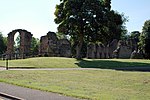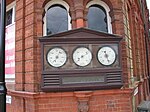Dudley Tunnel

Dudley Tunnel is a canal tunnel on the Dudley Canal Line No 1, England. At about 3,172 yards (2,900.5 m) long, it is now the second longest canal tunnel on the UK canal network today. (Standedge Tunnel is the longest, at 5,456 yards (4,989.0 m), and the 3,931 yards (3,594.5 m) Higham and Strood tunnel is now rail only). However, since the Dudley Tunnel is not continuous this status is sometimes questioned: (the main tunnel is 2,942 yards (2,690.2 m), Lord Ward's tunnel is 196 yards (179.2 m) and Castle Mill basin is 34 yards (31.1 m)). In 1959 the British Transport Commission sought to close the tunnel but this led to an Inland Waterways Association-organised massed protest cruise in 1960. The tunnel was however closed in 1962; and was further threatened with permanent closure by British Railways who wished to replace a railway viaduct at the Tipton portal with an embankment and a culvert. However, this never happened as the railway was closed in 1968 and the disused bridge demolished in the 1990s.The tunnel was reopened in 1973, as a result of restoration, which had been a collaboration between local volunteers (originally the Dudley Canal Tunnel Preservation Society, later the Dudley Canal Trust), and the local authority, Dudley Borough Council. The opening ceremony was advertised as "TRAD 1973 - Tunnel Reopening at Dudley".
Excerpt from the Wikipedia article Dudley Tunnel (License: CC BY-SA 3.0, Authors, Images).Dudley Tunnel
Rose Garden,
Geographical coordinates (GPS) Address Nearby Places Show on map
Geographical coordinates (GPS)
| Latitude | Longitude |
|---|---|
| N 52.517544 ° | E -2.086741 ° |
Address
Rose Garden
DY1 4EU , Eve Hill
England, United Kingdom
Open on Google Maps








